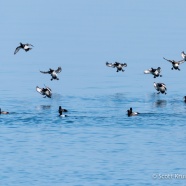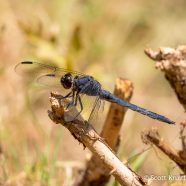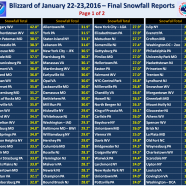Scaup Surge
Thanks to recent warm temperatures and favorable winds, Greater Scaup (Aythya marila) like those shown here are now on the move back to the north, and during the past couple of weeks their numbers have been growing across the region. While you can find some throughout the winter in open areas on large bodies of water such as Lake Erie, most members of this species migrate south to evade the cold. We have been able to enjoy several thousand – probably 5,000 or 6,000 and maybe more – in the waters of Long Island Sound off Stratford Point. Most stay rather far offshore and away from...
Read MoreSlaty Skimmer
This Slaty Skimmer (Libellula incesta) is not hanging out in the desert, though it may look like that from this photo. Much of the region is running a strong rainfall deficit from the past few months with many areas abnormally dry and some in the midst of moderate drought. This combined with higher than average temperatures and aggressive destruction of vegetation in areas around ponds like this one (I promise there is a pond out of sight in this photo with actual water) can make what was a favorable area for insects and thus birds and other wildlife far less attractive and beneficial. Water...
Read MoreLoch Ness Monster?
Loch Ness Monster? Ut oh, it’s surfacing, and it’s looking directly at me! Or maybe not…but close enough in look and unfortunately somewhat in status. Horned Grebes (Podiceps auritus) are listed on the International Union for the Conservation of Nature (IUCN) Red List of Threatened Species as “Vulnerable”. We often do not get to enjoy them close-up like these views I was afforded last week. While their wintering plumage is meant to camouflage them in the water, their piercing red eyes are a bright beacon on even the dullest of late winter days. Keep an eye out...
Read MoreGreater Scaup
There were so many more ducks pushed out into the open ocean during the past two winters with the icy Great Lakes and nearly every inland body of water being locked up for most of the season in the Northeast. This year species like these Greater Scaup can still be found in more northerly areas with sometimes historic warmth occurring. As of yesterday the Great Lakes ice cover was only at 7.2% compared to 2015’s 49.0% and the even more frozen 77.7% in 2014. Our local Lake Erie was essentially entirely ice at this point in the last two winters because it is so shallow, measuring at 94.5%...
Read MoreHistoric Blizzard of 2016
Here we are again – another year, another crippling blizzard crushing the Northeast. This century has been extremely volatile weather-wise for much of the east coast, and the winter seasons alone have been historic in some way nearly every year. We thought for a while that El Niño would keep it a more routine sort of winter, but once it showed it would be the strongest El Niño of all time there were a lot of unknowns…especially after historic warmth had its hold on us through the end of 2015. Basking in the 70s for Christmas, it was nevertheless certain that a cold air mass would...
Read More








